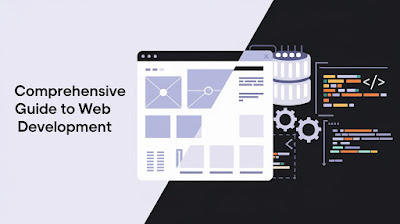Web development is the process of creating and building websites. It involves a combination of skills and technologies, including HTML, CSS, JavaScript, and various programming languages. In this article, we'll explore the key aspects of web development .
The Foundation of Web Development: HTML, CSS, and JavaScript
The Foundation of Web Development: HTML, CSS, and JavaScript :
- HTML (HyperText Markup Language): This is the backbone of web pages. It defines the structure and content of a website, including text, images, links, and other elements.
- CSS (Cascading Style Sheets): CSS is responsible for the visual presentation of web pages. It styles elements, defines layouts, and adds visual effects.
- JavaScript: A programming language that adds interactivity and dynamic features to web pages. It can be used to create animations, handle user input, and communicate with servers.
Web Development Tools and Technologies
Web development is typically divided into two main areas: frontend and backend development.
- Frontend Development: This involves creating the user interface of a website, which is what users see and interact with. It primarily focuses on HTML, CSS, and JavaScript.
- Backend Development: This involves handling the server-side logic and database interactions. It often requires knowledge of programming languages like Python, Ruby, PHP, or JavaScript (Node.js).
Web Development Tools and Technologies
- Code Editors and IDEs: These tools provide a structured environment for writing and editing code. Popular options include Visual Studio Code, Sublime Text, and WebStorm.
- Version Control Systems: Git is the most widely used version control system for managing code changes and collaborating with others.
- Frameworks and Libraries: These can streamline development and provide pre-built components. Popular options include React, Angular, Vue.js, and jQuery.
- Build Tools: Tools like Webpack and Parcel can automate tasks like bundling, minification, and transpilation.
- Testing Tools: Unit testing and integration testing help ensure code quality and prevent bugs.
The Web Development Process
- Planning and Design: This involves understanding the project requirements, creating wireframes or mockups, and defining the website's structure and functionality.
- Development: This is where you write the actual code using HTML, CSS, and JavaScript.
- Testing: Thorough testing is crucial to identify and fix any bugs or issues.
- Deployment: Once the website is developed and tested, it needs to be deployed to a web server so it can be accessed online.
- Maintenance and Updates: Websites require ongoing maintenance to ensure they remain up-to-date, secure, and perform well.
Tips for Aspiring Web Developers
- Start with the basics: Learn HTML, CSS, and JavaScript thoroughly before diving into more advanced topics.
- Practice regularly: The best way to improve your skills is to practice regularly and build projects.
- Join online communities: Connect with other developers to learn from their experiences and get help when needed.
- Stay updated: The web development landscape is constantly evolving, so it's important to stay updated on the latest trends and technologies.
Conclusion
By following these guidelines and continuously learning, you can embark on a rewarding career in web development. Remember, the most important thing is to have fun and enjoy the process of creating something new.
